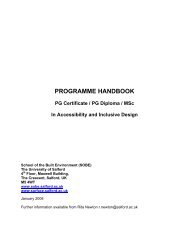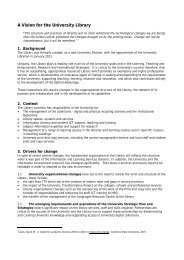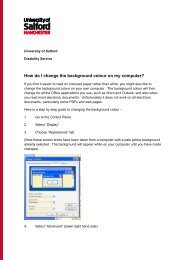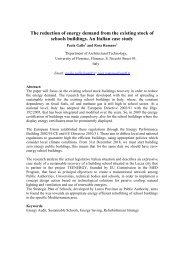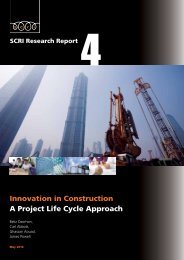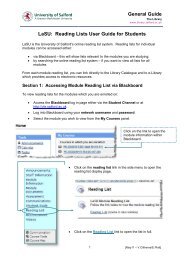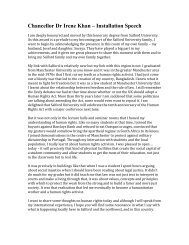Dry-lining versus a hemp and lime insulating render - University of ...
Dry-lining versus a hemp and lime insulating render - University of ...
Dry-lining versus a hemp and lime insulating render - University of ...
Create successful ePaper yourself
Turn your PDF publications into a flip-book with our unique Google optimized e-Paper software.
Figure 11: Increase MC content in brick behind DL on left, drop in MC in brick behind Hemp rightIt seems the <strong>hemp</strong>/<strong>lime</strong> <strong>render</strong> is very effective at transporting moisture but to be mosteffective it needs to ―breathe‖. It works better with more porous walls e.g. brick, <strong>and</strong>will benefit from ventilation during the drying period. The conditions present in thecottage <strong>hemp</strong>/<strong>lime</strong> project at CAT are possibly some <strong>of</strong> the harshest that might beencountered in the United Kingdom for internal insulation <strong>of</strong> a solid wall. Thesimulations indicate that even in this harsh environment the <strong>hemp</strong> <strong>lime</strong> can be effectiveat reducing moisture load in the wall. However, the prevalent conditions appear tocontribute to abnormally high saturated moisture concentrations at specific points <strong>and</strong>times.The moisture spikes in <strong>hemp</strong>/<strong>lime</strong> are time dependent <strong>and</strong> <strong>of</strong> limited duration. In DL thespikes are associated with a build-up <strong>of</strong> moisture in the wall immediately adjoining thewall/air gap interface. Therefore, moisture spikes in <strong>hemp</strong>/<strong>lime</strong> can regarded as atransient issue whereas in dry <strong>lining</strong> it represents a long term problem than in DL whichcould lead to long term problems5 ConclusionsHemp <strong>and</strong> binder <strong>render</strong>s take time to dry out <strong>and</strong> during this process their dynamicthermal performance as measured with the in-situ U-value is worse than anticipatedwhereas the DL is out performing its U-value predictions by 22% most likely due to anunderestimation <strong>of</strong> the U-value <strong>of</strong> the slate wall in combination with a small thermalmass effect.The RH behind the DL is in keeping with the WUFI model <strong>and</strong> is 100% the whole timeindicating that with a st<strong>and</strong>ard vapour barrier that moisture will build up behind DL <strong>and</strong>in the wall. This could induce rot <strong>and</strong> mould behind the DL <strong>and</strong> the moisture build up inthe wall increase it thermal conductivity worsening thermal performance <strong>and</strong> lead to anincreased risk in frost damage in the wall. Although from the monitoring it isimpossible to discern if the <strong>hemp</strong> <strong>render</strong> will dry out the adjacent wall this did occur inthree separate WUFI models under differing conditions. This is therefore indicative thatthe Hemp <strong>render</strong> will actively dry out an underlying wall which should improve itsthermal performance <strong>and</strong> reduce the risk <strong>of</strong> frost damage despite the coldertemperatures resultant from the insulation effects <strong>of</strong> the <strong>render</strong>.13







